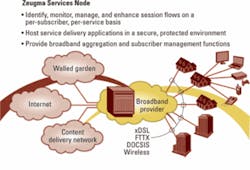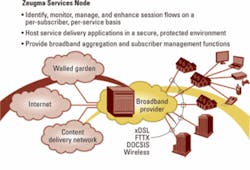by Meghan Fuller Hanna
After more than four years of development, startup Zeugma Systems has unveiled its flagship product, a broadband edge device that belongs to an emerging class of equipment known as the service delivery router. Dubbed the Zeugma Services Node (ZSN), the new carrier-grade device combines compute and networking horsepower in a single box, enabling broadband service providers to identify and monitor session flows on a per-subscriber, per-service basis.
Zeugma believes today's broadband service providers lack a critical functionality: the ability to identify and monitor each and every session flow traversing their network. Once they have that ability, says vice president of marketing Kevin Walsh, "they'll find themselves in a position where they can better manage, from a quality-of-service standpoint, those traffic flows and even, possibly, customize some of those traffic flows."Enter the ZSN, which can enable finely tuned ad insertion, quality-of-service-enhanced over-the-top video, content and URL filtering, enhanced voice over IP, and active quality-of-experience monitoring, among other applications.
The ZSN occupies the same space in the network as three existing network elements: the edge router, broadband remote access server (BRAS), and deep packet inspection device. The ZSN was designed to work in conjunction with these devices, but in greenfield builds or as a part of a general network upgrade, it could replace them. The ZSN includes broadband routing, subscriber management, and broadband aggregation functions as well as new building blocks, among them a linearly scalable compute grid comprising a number of compute blades. At its fullest capacity, says Walsh, the ZSN can scale up to 520,000 DMIPS or Dhrystone millions of instructions per second, which is the equivalent of about 27,000 first-generation Pentium PCs.
This compute power is coupled with the second building block, up to 720 Gbits/sec of unidirectional traffic capacity on the 14-slot Z7 version of the ZSN and 240 Gbits/sec on the more compact six-slot Z2 version. The traffic blades come in two configurations: 10�1-Gigabit Ethernet or 6�10-Gigabit Ethernet ports. In addition to high-speed broadband aggregation and traffic forwarding, Zeugma's traffic blades also provide deep packet inspection capability to give service providers better visibility into their networks.
The third building block is the Zeugma Open Application Sandbox (OAS), a native application execution environment. Similar to general-purpose operating systems like Windows or Linux, the Zeugma OAS provides both application program interfaces for system control functions and a secure environment that isolates applications from external threats, from each other, and from the system itself. Zeugma Systems has written applications, but as Walsh explains, "service providers themselves can write applications that run in the sandbox, and third parties can write applications that run in the sandbox."
With these building blocks in place, the broadband service provider can then begin to selectively promote certain traffic going to specific devices within targeted subscriber households.
Zeugma's message already appears to be resonating with Tier 1 providers; the vendor is currently in trials with several North American and European carriers, one of which has been publicly identified as British Telecom (www.bt.com).
"We are currently investigating the Zeugma Services Node's capabilities and are excited by the potential of the technology," says Kevin Wollard, technical strategist at BT. "Whether BT, Zeugma, system integrators, or third-party developers write the applications, the ZSN appears to offer the embedded compute resources able to support them."

